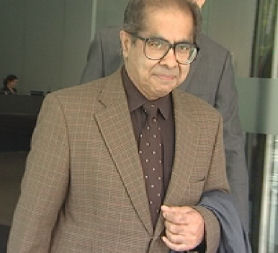G20 pathologist faces being struck off
The General Medical Council will announce later today whether it will bar the forensic pathologist who botched the Ian Tomlinson G20 post mortem from further practice, writes Simon Israel.

The General Medical Council will announce later whether to bar the forensic pathologist who botched the Ian Tomlinson G20 post mortem from further practice.
Dr Mohammed Freddy Patel was found guilty of serious misconduct and irresponsible behaviour in three other investigations into suspicious deaths.
The 63-year-old has already been suspended from the Home Office register of forensic pathologists over his handling of the Tomlinson case, but is still carrying out post mortems for various coroners in London.
Dr Patel was said by the GMC panel to have failed to identify marks on the body of a five-year-old girl which suggested she had been violently attacked prior to her death.
The GMC panel said Dr Patel’s conduct was ‘irresponsible’ and not of the standard expected of a Home Office pathologist.
He was also said to have behaved in a way which was liable to bring the profession into disrepute when he changed the cause of a woman’s death to satisfy her family.
Dr Patel has been a forensic pathologist for over thirty years but his comptence was challenged when the Metropolitan Police complained after he decided that the first victim of a serial murderer who became known as the Camden Ripper had died from natural causes.
Girl’s death
Last week chairman of the GMC panel Richard Davies said Dr Patel’s report into the death of the five-year-old girl, who had been admitted to hospital with a head injury following what was said to be a “serious fall”, gave no details of so-called “marks of violence”.
In Dr Patel’s report he said there was no “significant” marks of violence. Dr Patel told the panel that this meant there were no marks relevant to the child’s death.
Mr Davies said: “If there were no significant marks of violence in your view, by implication there were some marks of violence.”
Evidence was shown to the panel that indicated marks which had been visible to the naked eye. However, Dr Patel did not identify them in his report of 17 September 2002. He also failed to comment on their possible significance.
Mr Davies said the panel considered it “probable” that Dr Patel “performed only a cursory external examination of the body”.
“Had you acted differently, it is possible that you might have probed marks above the scapula (shoulder blade) which was later shown to be injured,” he added.
-
Latest news
-
As India goes to the polls in the world’s largest election – what do British-Indians think?6m

-
Tees Valley: Meet the candidates in one of the biggest contests coming up in May’s local elections4m

-
Keir Starmer says public sector reform will be a struggle7m

-
Nicola Sturgeon’s husband Peter Murrell charged with embezzlement of funds from SNP1m

-
Ukraine might finally get $60billion in American weapons and assistance to defend against Russia3m

-




